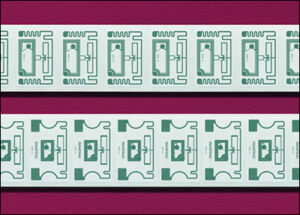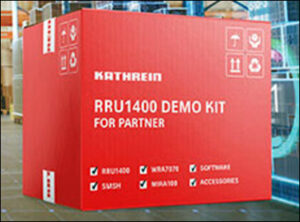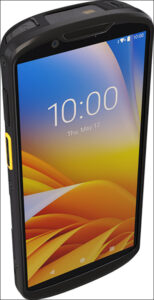May 12, 2022Presented here are recent news announcements in the RFID and IoT industry.
- Avery Dennison Unveils Dual-Frequency RFID Inlays for Retail, Healthcare
- Kathrein Solutions Intros RFID Test and Demo Kit
- Zebra Offers Mobile Computing Solution for Front-Line Workers
- NFC Forum Launches Wireless Charging Certification Program
- Semtech, CITiLIGHT Collaborate on Smart Street Lighting, LoRaWAN
- Litmus, Google Cloud Develop AI Manufacturing Platform
Avery Dennison Unveils Dual-Frequency RFID Inlays for Retail, Healthcare
Avery Dennison Smartrac has launched two additions to its dual-frequency (DF) range of RFID inlays, which combine Near Field Communication (NFC) and UHF RFID functionality to enable item-level tagging. The company's AD Medio Web DF EM4425 and AD Web DF EM4425 V12 inlays and tags are designed for brand protection, supply chain management and customer engagement, Avery Dennison reports. The AD Medio Web DF has been developed for pharmaceuticals and healthcare applications, while the AD Web DF is intended for retail use cases.

Avery Dennison's AD Medio Web DF EM4425 and AD Web DF EM4425 V12 inlays and tags
Operating in both the HF and UHF RFID frequency ranges, these products are suitable for inventory management and product authentication, the company reports, enabling a consistent experience regardless of channel. The technology also allows for shared memory functionality. By using both the UHF and HF protocols, each interface can update product information in real time, Avery Dennison reports. With RFID, retailers can make inventory and supply chain management more cost-effective—and with up-to-date inventory information, they can know where an item is located within a store or in the supply chain. This, according to the company, can protect them against theft, improve inventory efficiency and enable faster product returns.
NFC technology allows consumers to verify the authenticity of a purchased product and interact with the brand before, during and after that purchase, both in-store and at home via an NFC-enabled device. They can access detailed product information, such as carbon footprint analysis, by tapping the label with their phone. For pharmaceutical manufacturers, the technology could offer medical information such as a medication's dosage, origin and ingredients.
AD Medio Web DF EM4425 tags have a form factor of 48 millimeters by 31.5 millimeters (1.89 inch by 1.24 inch), which can be converted into end-application usage, and they are available in a paper tag delivery format. The tags feature EM Microelectronic's EM4425 V12 echo-V IC, which comes with 2,048 bits of shared user memory. It is accessible via UHF and HF RFID frequencies, enabling the use of generally available readers (NFC-enabled smartphones) as supplements to dedicated UHF or HF reader infrastructures.
The inlays and tags are sized at 53 millimeters by 33 millimeters (2.08 inch by 1.29 inch). They can be converted into end-application usage, are available in both paper tag and wet delivery formats, and feature EM's EM4425 V12 echo-V IC. The inlays are compliant with the ISO 9001:2015 Quality Management and ISO 14001:2015 Environmental Management standards.
Kathrein Solutions Intros RFID Test and Demo Kit
Kathrein Solutions, a manufacturer of RFID hardware for industrial applications, has announced that it is extending its partner strategy with a new campaign. With its Limited Edition RRU 1400 Test and Demo Kit, the company says, partners will be able to set up RFID readers, test various applications and meet customer requirements. The company's offer runs until June 30, 2022, with the goal of preparing Kathrein's partners to start new projects.

Kathrein Solutions' Limited Edition RRU 1400 Test and Demo Kit
The RRU 1400 accommodates the European Lower Band and Upper Band in a single device. The kit, consisting of the RRU 1400 RFID reader, a Smart Shelf antenna, other mid- and wide-range antennas, and associated cables, is supplied with software for a variety of applications. Partners can set up the reader via these applications for their own learning purposes, for an e-kanban shelf solution in production or for tracking goods in intralogistics.
The hardware training package comes with an RRU 1400 Reader, including power adapter; two Smart Shelf KRAI antennas; one WRA 7070 KRAI Wide Range antenna; one MIRA-100 Mid-Range antenna; a 3-inch FAKRA-FAKRA antenna cable; a 0.5-meter FAKRA-FAKRA antenna cable; a 1-meter FAKRA-TNC antenna cable; a 3-meter FAKRA-TNC antenna cable; and AccessManager and TagBlower software suites. The company's partner program includes ongoing training, as well as access to new products and Kathrein's test center and training academy, enabling businesses to simulate applications in test environments and prepare for proofs-of-concept.
"We see a demand on the market for small, compact designs for readers that are very versatile," said Thomas Heijnen, Kathrein Solutions' head of marketing and partner program, in a prepared statement. "This means they can be fitted directly to machines, for example, but are also suitable for conventional RFID gate applications. Through our high-quality products and the competence of our partners, we want to push forward with further digitization projects."
Zebra Offers Mobile Computing Solution for Front-Line Workers

Zebra's TC53/TC58 mobile computer
Zebra Technologies has announced its TC53/TC58 mobile computing series, intended to help businesses increase operational efficiencies, deploy new capabilities to the front line and reduce costs. Equipped with 5G and Wi-Fi 6E wireless and sensor technologies, the TC53/TC58 series allows front-line workers at retail, postal/courier and field service organizations to leverage mobile dimensioning, mobile point of sale (mPOS) and connected workforce applications.
The TC53/TC58 series features Zebra Dimensioning Certified Mobile Parcel, which utilizes an integrated time-of-flight (ToF) depth sensor to capture parcel dimensions and calculate shipping charges on Zebra mobile computers at the press of a button, saving time workers spend researching prices or manually measuring packages. The mobile computer is payment-ready with tap-to-pay functionality, and the devices can transform into a mobile-driven workstation, a fixed or hybrid point-of-sale system, a two-way push-to-talk radio, a PBX handset or an RFID reader for team collaboration.
The devices have been designed with front-line users, workplaces and workflows in mind, the company reports, in terms of use, durability and reliability. The TC53/TC58 series includes a 6-inch edge-to-edge display. Zebra's Intellifocus technology enables users to scan items in hand, across a room or on a top shelf rack, boosting worker productivity. The computer comes with an integrated 16-megapixel camera, with optional optical image stabilization to capture sharp, detailed photographs in order to document proof of condition and delivery.
"Businesses today are under intense pressure driven by dynamic changes in consumer demand that impact the customer experience," said Julie Johnson, Zebra's VP and general manager of enterprise mobile computing, in a prepared statement. "Our new flagship TC53/TC58 mobile computers represent the first in a new generation of Zebra devices that will help organizations redefine service and support levels while giving their mobile workers faster and more reliable access to the information they need to get their jobs done."
NFC Forum Launches Wireless Charging Certification Program
The NFC Forum, a global standards body for Near Field Communication (NFC) technology, has announced the availability of its Test Release 13.1 (TR13.1), which allows manufacturers to certify that their products comply with the NFC Wireless Charging (WLC) 2.0 specification as part of the NFC Forum Certification Program.
"TR13.1 testing and certification minimizes risk for the manufacturer and ensures consumers that products will work as promised," said Mike McCamon, the NFC Forum's executive director, in a prepared statement. "It means a product is interoperable with the broader NFC technology ecosystem. Certification demonstrates an organization's commitment to quality and usability. Wireless charging certification should be part of an NFC product's roadmap."
TR13.1 certification ensures interoperability across certified WLC 2.0 devices. One example of WLC 2.0 certification, the organization explains, involves using a smartphone or dedicated WLC 2.0 charging device to wirelessly charge small battery-operated devices, such as wireless earbuds, smart watches, digital pens, headsets, fitness trackers and other consumer products, at a power transfer rate of up to one watt. According to the NFC Forum, TR13.1 is backward-compatible and has no impact on existing NFC device classes for certification. NFC WLC certification for Type 2 Tags is available now, and more tag types are expected to be added this year.
The Universal Stylus Initiative (USI) is the first organization to test with TR13 and achieve NFC Forum certification, the standards body notes. USI integrated NFC wireless charging into its active stylus specification, giving USI-enabled active styluses the capability to be wirelessly charged with a compatible notebook or other NFC charging device. USI mandates NFC Forum certification to improve the user experience for millions using active styluses with notebooks, tablets and phones, and USI-enabled active styluses are standard on Google Chromebooks.
"NFC WLC testing and certification create a number of opportunities for USI-enabled products," added Pete Mueller, USI's president, in the prepared statement. "Likely scenarios include a USI active stylus being used with an NFC-enabled notebook, tablet or mobile phone and also be wirelessly charged by the same devices. As long as your device has charge, your active stylus will not run out of power. Testing and certification are important steps to opening up even more possibilities for new products."
NFC Forum Certification is a free process that includes application, test result evaluation and decision. Certified products are listed on the NFC Forum's website and receive official certification documentation as proof of compliance. The organization partners with authorized and approved test labs to provide certification testing services. NFC card emulation has been added to the certification program for the wearable market, expanding the Forum's ecosystem to ensure interoperability.
Semtech, CITiLIGHT Collaborate on Smart Street Lighting, LoRaWAN
Semtech, a supplier of analog and mixed-signal semiconductors and algorithms, has announced its collaboration with CITiLIGHT, a provider of lighting solutions for smart cities, for its VELOCITi LMS lighting-management system. Since streetlights are fixed assets typically placed 40 to 50 meters apart, the VELOCITi LMS features Semtech's LoRa devices and uses the LoRaWAN standard to communicate large packets of data over a long range. According to CITiLIGHT, more than a million streetlights have been automated with the smart lighting solution, saving up to 1.29 billion kilowatt-hours of energy in more than 100 cities.
"Safety is a critical part of any city," said Aman Chawla, CITiLIGHT's CEO, in a prepared statement. "As we move toward smarter cities, our view of citizen safety also needs to evolve. This is where city street lighting plays an important role. The spots in the city that are dark or less brightly lit are the ones that are most vulnerable to crime and accidents, and VELOCITi LMS is a solution to this issue. Controlling street lighting is a unique challenge which entails work on both the hardware and network of the system. Semtech's LoRa devices and LoRaWAN were the ideal solution for smart cities, as the technology is able to solve both hardware and network needs due to each streetlight requiring to be metered, while accounting for additional data such as daylight, motion and temperature."
The VELOCITi LMS system keeps streetlights connected and monitored in real time, the company reports, from anywhere and without dependence on field personnel. Any command given to the lights, such as changes in schedule or intensity, are executed within seconds, CITiLIGHT reports, as the system offers less than five-second command latency and 0.5 to 1 percent accuracy on metered data. Semtech's LoRa devices and the LoRaWAN standard complement the streetlight system, the partners note, and the technology can support larger data packets based on a city's needs and communication over a long range.
"Real-time analytics are aiding in the growth of smart cities," added Marc Pégulu, the VP of IoT product marketing and strategy for Semtech's Wireless and Sensing Products Group, in the statement. "Semtech's LoRa devices and the LoRaWAN standard are adding intelligence and networking to street lighting that is creating better and more sustainable smart cities. This, in turn, creates a smarter planet that also improves lives of citizens globally through the reduction in energy usage."
Litmus, Google Cloud Develop AI Manufacturing Platform
Litmus has announced they it has co-developed its Manufacturing Connect platform with Google Cloud, with the goal of simplifying the task of collecting data from disparate factory devices and exposing it to Google Cloud data and artificial intelligence (AI) applications. Manufacturing Connect integrates with Google Cloud to provide factory data to manufacturing engineers, the company explains, enabling them to improve operations at scale. The edge platform supports more than 250 machine communication protocols, with data structured and stored locally and sent to Google Cloud for analytics and AI. The platform can deploy and manage AI and machine learning models at the edge for closed-loop AI.
"Improving manufacturing operations with analytics and AI capabilities has become critical for organizations looking to scale their digital transformation initiatives," said Charlie Sheridan, Google Cloud's technical director for industry solutions and manufacturing, in a prepared statement. "By making Manufacturing Connect easy to integrate and deploy with Google Cloud, Litmus is providing customers with the technologies needed to inform their smart manufacturing operations and succeed in the cloud."
Manufacturing Connect is deployed as an edge-computing platform with such capabilities as data collection and engineering, data visualizations and KPI dashboards, containerized application deployment and machine learning model runtime. Manufacturing Connect adds a management layer deployed on Google Cloud, the partners explain, to let customers control and scale their data, applications and machine learning models across multiple sites.
"Manufacturing Connect solves OT complexity to provide a simple and fast way to get data to Google Cloud with just a few clicks," added John Younes, Litmus's co-founder and COO, in the statement. "Our near-instant connectivity and seamless integration means customers don't have to think about how to get access to the data, they can focus on how to use the data to maximize their smart manufacturing investments and time-to-value."
Exhibitors at RFID Journal LIVE! 2022 will offer tagging solutions for a wide variety of applications. To learn more, visit the event's website.

